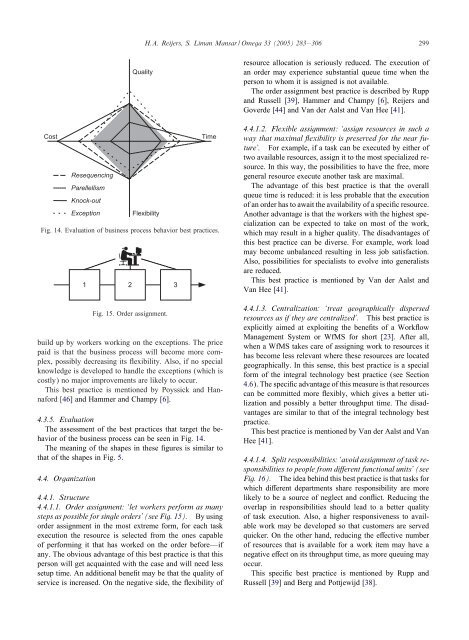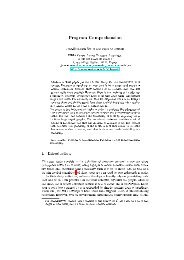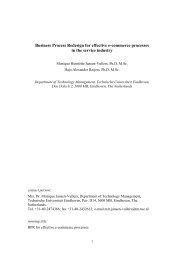Best practices in business process redesign: an overview and ...
Best practices in business process redesign: an overview and ...
Best practices in business process redesign: an overview and ...
Create successful ePaper yourself
Turn your PDF publications into a flip-book with our unique Google optimized e-Paper software.
Cost<br />
Resequenc<strong>in</strong>g<br />
Parellellism<br />
Knock-out<br />
Exception<br />
Quality<br />
H.A. Reijers, S. Lim<strong>an</strong> M<strong>an</strong>sar / Omega 33 (2005) 283 – 306 299<br />
Flexibility<br />
Time<br />
Fig. 14. Evaluation of bus<strong>in</strong>ess <strong>process</strong> behavior best <strong>practices</strong>.<br />
1<br />
2<br />
Fig. 15. Order assignment.<br />
build up by workers work<strong>in</strong>g on the exceptions. The price<br />
paid is that the bus<strong>in</strong>ess <strong>process</strong> will become more complex,<br />
possibly decreas<strong>in</strong>g its exibility. Also, if no special<br />
knowledge is developed to h<strong>an</strong>dle the exceptions (which is<br />
costly) no major improvements are likely to occur.<br />
This best practice is mentioned by Poyssick <strong>an</strong>d H<strong>an</strong>naford<br />
[46] <strong>an</strong>d Hammer <strong>an</strong>d Champy [6].<br />
4.3.5. Evaluation<br />
The assessment of the best <strong>practices</strong> that target the behavior<br />
of the bus<strong>in</strong>ess <strong>process</strong> c<strong>an</strong> be seen <strong>in</strong> Fig. 14.<br />
The me<strong>an</strong><strong>in</strong>g of the shapes <strong>in</strong> these gures is similar to<br />
that of the shapes <strong>in</strong> Fig. 5.<br />
4.4. Org<strong>an</strong>ization<br />
4.4.1. Structure<br />
4.4.1.1. Order assignment: ‘let workers perform as m<strong>an</strong>y<br />
steps as possible for s<strong>in</strong>gle orders’ (see Fig. 15). By us<strong>in</strong>g<br />
order assignment <strong>in</strong> the most extreme form, for each task<br />
execution the resource is selected from the ones capable<br />
of perform<strong>in</strong>g it that has worked on the order before—if<br />
<strong>an</strong>y. The obvious adv<strong>an</strong>tage of this best practice is that this<br />
person will get acqua<strong>in</strong>ted with the case <strong>an</strong>d will need less<br />
setup time. An additional bene t may be that the quality of<br />
service is <strong>in</strong>creased. On the negative side, the exibility of<br />
3<br />
resource allocation is seriously reduced. The execution of<br />
<strong>an</strong> order may experience subst<strong>an</strong>tial queue time when the<br />
person to whom it is assigned is not available.<br />
The order assignment best practice is described by Rupp<br />
<strong>an</strong>d Russell [39], Hammer <strong>an</strong>d Champy [6], Reijers <strong>an</strong>d<br />
Goverde [44] <strong>an</strong>d V<strong>an</strong> der Aalst <strong>an</strong>d V<strong>an</strong> Hee [41].<br />
4.4.1.2. Flexible assignment: ‘assign resources <strong>in</strong> such a<br />
way that maximal exibility is preserved for the near future’.<br />
For example, if a task c<strong>an</strong> be executed by either of<br />
two available resources, assign it to the most specialized resource.<br />
In this way, the possibilities to have the free, more<br />
general resource execute <strong>an</strong>other task are maximal.<br />
The adv<strong>an</strong>tage of this best practice is that the overall<br />
queue time is reduced:it is less probable that the execution<br />
of <strong>an</strong> order has to await the availability of a speci c resource.<br />
Another adv<strong>an</strong>tage is that the workers with the highest specialization<br />
c<strong>an</strong> be expected to take on most of the work,<br />
which may result <strong>in</strong> a higher quality. The disadv<strong>an</strong>tages of<br />
this best practice c<strong>an</strong> be diverse. For example, work load<br />
may become unbal<strong>an</strong>ced result<strong>in</strong>g <strong>in</strong> less job satisfaction.<br />
Also, possibilities for specialists to evolve <strong>in</strong>to generalists<br />
are reduced.<br />
This best practice is mentioned by V<strong>an</strong> der Aalst <strong>an</strong>d<br />
V<strong>an</strong> Hee [41].<br />
4.4.1.3. Centralization: ‘treat geographically dispersed<br />
resources as if they are centralized’. This best practice is<br />
explicitly aimed at exploit<strong>in</strong>g the bene ts of a Work ow<br />
M<strong>an</strong>agement System or WfMS for short [23]. After all,<br />
when a WfMS takes care of assign<strong>in</strong>g work to resources it<br />
has become less relev<strong>an</strong>t where these resources are located<br />
geographically. In this sense, this best practice is a special<br />
form of the <strong>in</strong>tegral technology best practice (see Section<br />
4.6). The speci c adv<strong>an</strong>tage of this measure is that resources<br />
c<strong>an</strong> be committed more exibly, which gives a better utilization<br />
<strong>an</strong>d possibly a better throughput time. The disadv<strong>an</strong>tages<br />
are similar to that of the <strong>in</strong>tegral technology best<br />
practice.<br />
This best practice is mentioned by V<strong>an</strong> der Aalst <strong>an</strong>d V<strong>an</strong><br />
Hee [41].<br />
4.4.1.4. Split responsibilities: ‘avoid assignment of task responsibilities<br />
to people from di erent functional units’ (see<br />
Fig. 16). The idea beh<strong>in</strong>d this best practice is that tasks for<br />
which di erent departments share responsibility are more<br />
likely to be a source of neglect <strong>an</strong>d con ict. Reduc<strong>in</strong>g the<br />
overlap <strong>in</strong> responsibilities should lead to a better quality<br />
of task execution. Also, a higher responsiveness to available<br />
work may be developed so that customers are served<br />
quicker. On the other h<strong>an</strong>d, reduc<strong>in</strong>g the e ective number<br />
of resources that is available for a work item may have a<br />
negative e ect on its throughput time, as more queu<strong>in</strong>g may<br />
occur.<br />
This speci c best practice is mentioned by Rupp <strong>an</strong>d<br />
Russell [39] <strong>an</strong>d Berg <strong>an</strong>d Pottjewijd [38].






